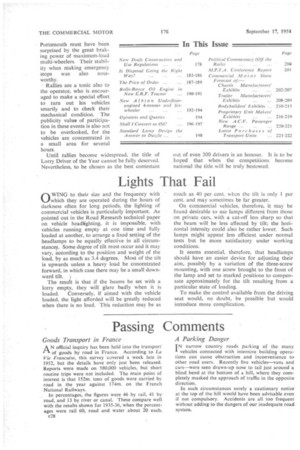Lights That Fail
Page 74

If you've noticed an error in this article please click here to report it so we can fix it.
OWING to their size and the frequency with which they are operated during the hours of darkness often for long periods, the lighting of commercial vehicles is particularly important. As pointed out in the Road Research technical paper on vehicle headfighting, it is impossible, with vehicles running empty at one time and fully loaded at another, to arrange a fixed setting of the headlamps to be equally effective in all circumstance. Some degree of tilt must occur and it may vary, according to the position and weight of the load, by as much as 3.4 degrees. Most of the tilt is upwards unless a heavy load be concentrated forward, in which case there may be a small downward tilt. '} The result is that if the beams be set with a lorry empty, they will glare badly when it is loaded. Conversely, if aimed with the vehicle loaded, the light afforded will be greatly reduced when there is no load. This reduction may be as much as 40 per cent. when the tilt is only 1 per cent. and may sometimes be far greater.
On commercial vehicles, therefore, it may be found desirable to use lamps different from those on private cars, with a cut-off less sharp so that the beam will be less affected by tilt; the horizontal intensity could also be rather lower. Such lamps might appear less efficient under normal tests but be more satisfactory under working conditions.
It seems essential, therefore, that headlamps should have an easier device for adjusting their aim, possibly by a variation of the three-screw mounting, with one screw brought to the front of the lamp and set to marked positions to compensate approximately for the tilt resulting from a particular state of loading.
To make the control available from the driving seat would, no doubt, be possible but would introduce more complication.












































































































































































































